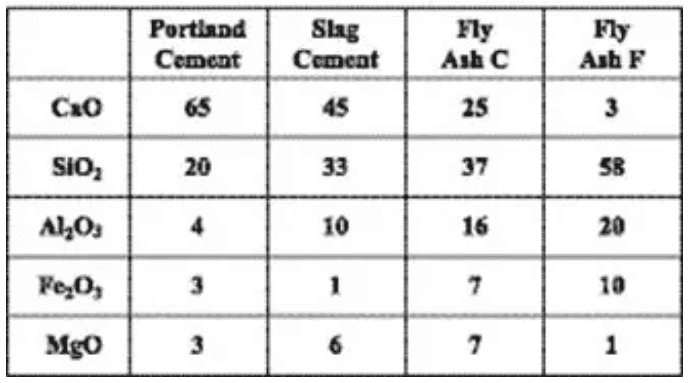1.Auxiliary cementitious material
The components of modern concrete are usually mixed with auxiliary cementing materials (SCM). These materials are usually by-products of natural materials produced in other industrial production processes. Among them, some materials require in-depth treatment to be suitable for concrete. Some of these materials have gelling properties; in addition, there are some materials that do not have gelling properties, which we call pozzolan materials.
2. Chemical composition and composition stability of slag powder and fly ash
Slag powder and fly ash are the two most widely used auxiliary cementing materials in the concrete industry. Nowadays, most concrete production processes are mixed with one or two of these materials. Because of this, their performance is frequently compared to each other by concrete technicians in order to find the best concrete ratio.
Although these materials have similarities in chemical composition, there are still large differences in their effects on the performance of concrete. This difference is mainly based on the different proportions of oxides in each component of the material (Table 1).
Table 1 The main oxide composition in different cementitious materials
Figure 1 Ternary phase diagrams of oxides in different cementitious materials
As shown in the ternary phase diagram in Figure 1, the chemical composition of slag powder is closer to Portland cement than to fly ash. This is also one of the reasons that slag powder can be used in concrete in large quantities. Slag powder and fly ash can partially replace Portland cement in concrete. In ordinary concrete, the amount of slag powder mix can reach 50% (in some special applications, such as mass concrete, the amount of slag powder mix can reach 80%). The fly ash content is generally controlled between 20% and 30%.
Slag powder is a by-product of the iron-making process, and the whole process is strictly controlled so that even though the source of raw materials fluctuates, its chemical composition can remain relatively stable. Fly ash is a byproduct of the combustion of pulverized coal in coal-fired power plants, and the differences in raw materials will directly lead to fluctuations in the chemical composition of fly ash.
3. The Similarities and Differences of Impact of Slag Powder and Fly Ash on Concrete Performance
Compared with fly ash, the chemical composition of slag powder fluctuates less. Therefore, the quality stability of concrete mixed with slag powder is better than that of concrete mixed with fly ash.
1、The influence of both on the properties of plastic concrete
- Water reduction: Using these two materials will reduce the amount of water required for concrete to achieve specified flow properties. The reason that slag powder has a water-reducing effect is that it can affect the characteristics of the suspension and its adsorption performance. (New Weishen material: the particle size of the slag powder is reasonable, and the appropriate amount has a certain water-reducing effect. Indeed, the microscopic shape of the slag powder is irregular glass body and its water absorption is compared to silicate. Cement is smaller and has a certain degree of water reduction.) For fly ash, this is mainly due to its better morphological effect and size effect ( Wei Shen New Material: The shape of fly ash is spherical glass balls, Play the role of ball bearing, thereby showing a certain degree of water reduction). Therefore, this causes these two materials to have a certain degree of water-reducing effect on the concrete mix.
- Air content: There are many different factors that affect the air content of concrete. The difference in the carbon content of fly ash is a major factor that causes fluctuations in the air content of concrete. The slag powder does not contain carbon, so it will not affect the stability of the air content of the concrete.
- Setting time: The mixing of slag powder and fly ash in the concrete will affect the initial setting time of the concrete. The setting time of concrete mixed with slag powder is shorter than that of concrete mixed with fly ash (Figure 2).
- Figure 2 Influence of slag powder and fly ash on the initial setting time
- Pumpability and shine collection: mixing slag powder and fly ash into concrete is equivalent to filling the voids of concrete with fine particles, which can greatly improve pumpability and shine collection of concrete.
2. The influence of both on the hardening performance of concrete
- Strength: The 28-day strength of concrete mixed with grade C slag powder and fly ash is higher than that of cement concrete mixed with grade F fly ash.
- Permeability: Under the normal dosage specified and tested in accordance with ASTM 1206 (Rapid Chloride Ion Penetration Test Method), concrete mixed with slag powder has lower performance than concrete mixed with ash Ruffles of grade F or grade C. Permeability.
- Sulphate erosion and alkaline aggregate reaction: adding grade F slag powder and fly ash can protect concrete from sulfate erosion and alkaline aggregate reaction. Grade C fly ash may not have this capability.
- Color: Compared with Portland cement concrete, concrete mixed with slag powder has a lighter color and higher reflectivity. C-grade fly ash and F-grade fly ash will make concrete appear light yellow or dark gray respectively.



